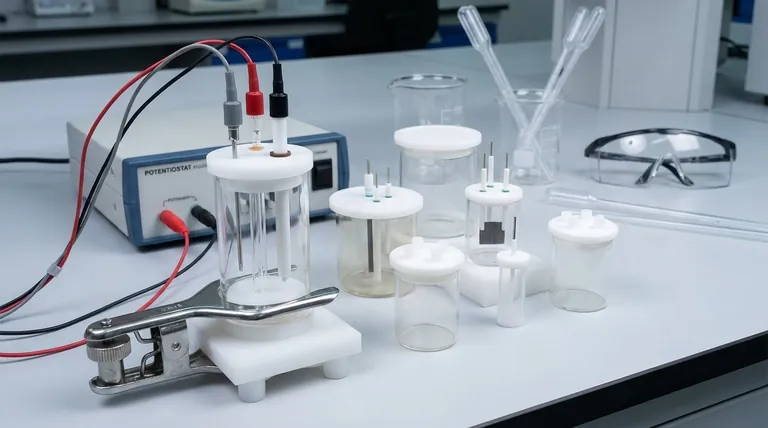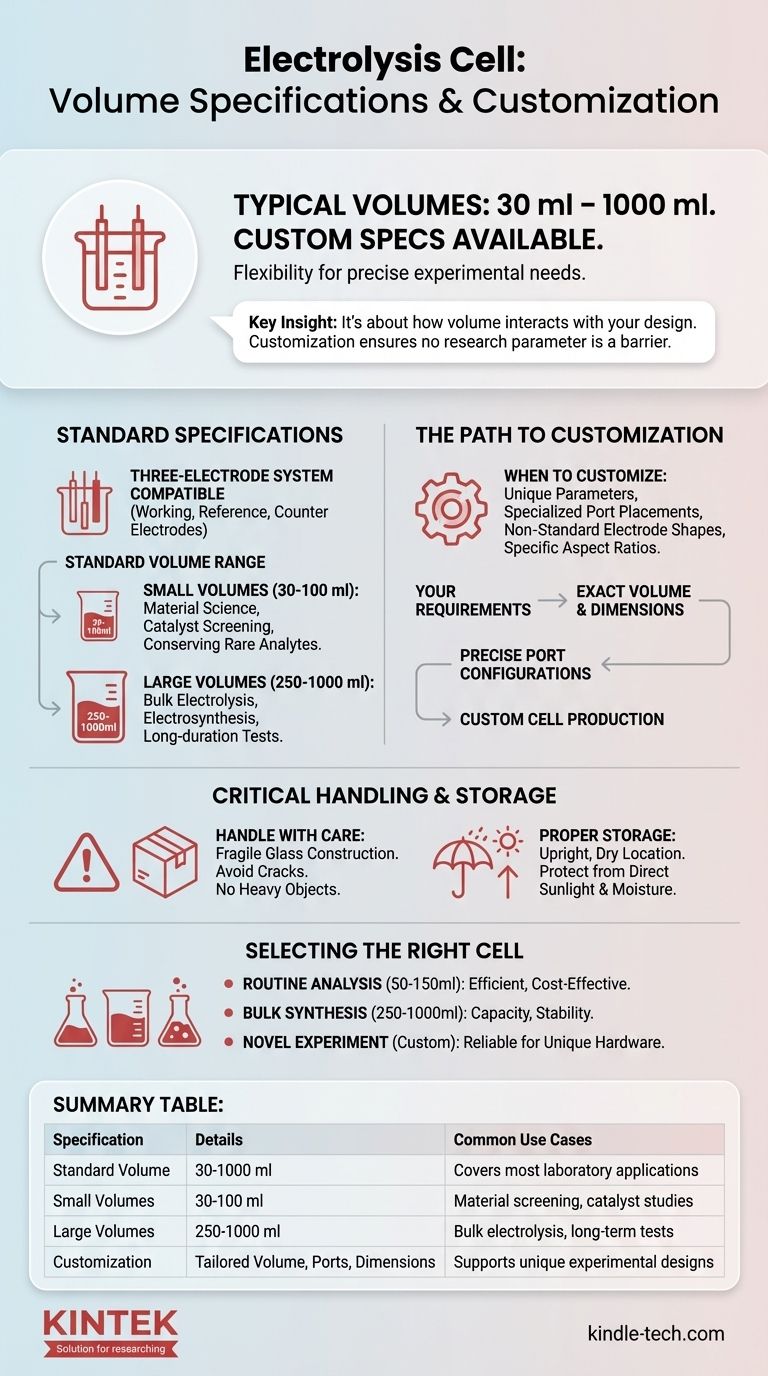To answer your question directly, this electrolysis cell is typically available in standard volumes ranging from 30 ml to 1000 ml. Crucially, custom specifications and sizes can be produced to meet specific experimental requirements, offering significant flexibility for researchers.
The core consideration is not just the volume, but how that volume interacts with your experimental design. While a wide range of standard sizes accommodates most three-electrode system applications, the option for full customization ensures that no unique research parameter is a barrier.

Understanding the Standard Specifications
An electrolysis cell is a foundational component in electrochemical studies. Understanding its standard configuration is the first step in selecting the correct tool for your work.
Common Application: The Three-Electrode System
This cell is explicitly designed for a three-electrode system. This setup is the standard for most electrochemical analysis, involving a working electrode, a reference electrode, and a counter electrode.
The cell's geometry is built to properly accommodate this arrangement, ensuring accurate and repeatable measurements.
Standard Volume Range: 30 ml to 1000 ml
The available range from 30 ml to 1000 ml covers a vast majority of common laboratory applications.
Smaller volumes (30 ml to 100 ml) are ideal for material science research, catalyst screening, or when working with expensive or rare analytes where sample conservation is critical.
Larger volumes (250 ml to 1000 ml) are typically used for bulk electrolysis, electrosynthesis, or experiments requiring larger electrode surface areas or longer duration stability tests.
The Path to Customization
While standard sizes are versatile, cutting-edge research often demands non-standard equipment. Customization is available for precisely these situations.
When to Consider a Custom Cell
You should pursue a custom cell if your experiment involves parameters that standard glassware cannot accommodate.
This often includes the need for unique port placements for specialized probes, non-standard electrode sizes or shapes, or specific aspect ratios (height vs. width) to control diffusion layers.
The Customization Process
The manufacturer can produce cells according to your exact requirements. This means you can specify the precise volume, dimensions, joint sizes, and port configurations needed for your experimental setup.
Critical Handling and Storage Considerations
Proper care is essential to ensure the longevity and integrity of the electrolysis cell, whether it is a standard or custom model.
Material and Fragility
These cells are typically made of glass, which makes them fragile. They must be handled with care to avoid cracks or breakage, which could compromise your experiment and safety.
Never place heavy objects on top of the cell.
Proper Storage Environment
The cell must be stored in an upright position in a dry location.
Protect it from direct sunlight and moisture, as environmental factors can degrade seals or affect the cleanliness of the glass surface over time.
Selecting the Right Cell for Your Experiment
Your choice of cell volume and configuration is a critical decision that directly impacts the quality of your electrochemical data.
- If your primary focus is routine analysis or material screening: A standard, smaller volume (e.g., 50-150 ml) is likely the most efficient and cost-effective choice.
- If your primary focus is bulk electrosynthesis or long-term testing: A larger standard volume (e.g., 250-1000 ml) will provide the necessary capacity and stability.
- If your primary focus is novel experimental design with unique hardware: Investing in a custom-designed cell is the most reliable path to achieving accurate results.
Choosing the correct electrolysis cell is the first step toward ensuring the integrity and success of your research.
Summary Table:
| Specification | Details | Common Use Cases |
|---|---|---|
| Standard Volume Range | 30 ml to 1000 ml | Covers most laboratory applications |
| Small Volumes (30-100 ml) | Ideal for material screening, catalyst studies | Conserves expensive or rare analytes |
| Large Volumes (250-1000 ml) | Suitable for bulk electrolysis, long-term tests | Requires larger electrode surface areas |
| Customization Options | Tailored volume, port placement, dimensions | Supports unique experimental designs |
Ensure your electrochemical research is built on a solid foundation. Whether you need a standard 50ml cell for routine analysis or a fully customized design for a novel experiment, KINTEK's expertise in lab equipment ensures you get the precise electrolysis cell your work demands. Our team can help you specify the exact volume, port configuration, and dimensions for accurate, repeatable results. Contact our specialists today to discuss your specific three-electrode system requirements and get a solution tailored to your laboratory's needs.
Visual Guide

Related Products
- Quartz Electrolytic Electrochemical Cell for Electrochemical Experiments
- H Type Electrolytic Cell Triple Electrochemical Cell
- Double-Layer Water Bath Electrolytic Electrochemical Cell
- H-Type Double-Layer Optical Electrolytic Electrochemical Cell with Water Bath
- Customizable PEM Electrolysis Cells for Diverse Research Applications
People Also Ask
- What are the operational procedures and safety precautions during an experiment using an all-quartz electrolytic cell? Ensure Safety and Accuracy in Your Lab
- What are the necessary steps to prepare an all-quartz electrolytic cell before an experiment? Ensure Accuracy and Safety
- What are the standard opening specifications for sealed and unsealed all-quartz electrolytic cells? Optimize Your Electrochemistry Setup
- What is the proper procedure for post-experiment cleanup and storage of an all-quartz electrolytic cell? Ensure Longevity and Reproducibility
- What precautions should be taken when handling and using an all-quartz electrolytic cell? Ensure Safe, Accurate, and Durable Performance



















